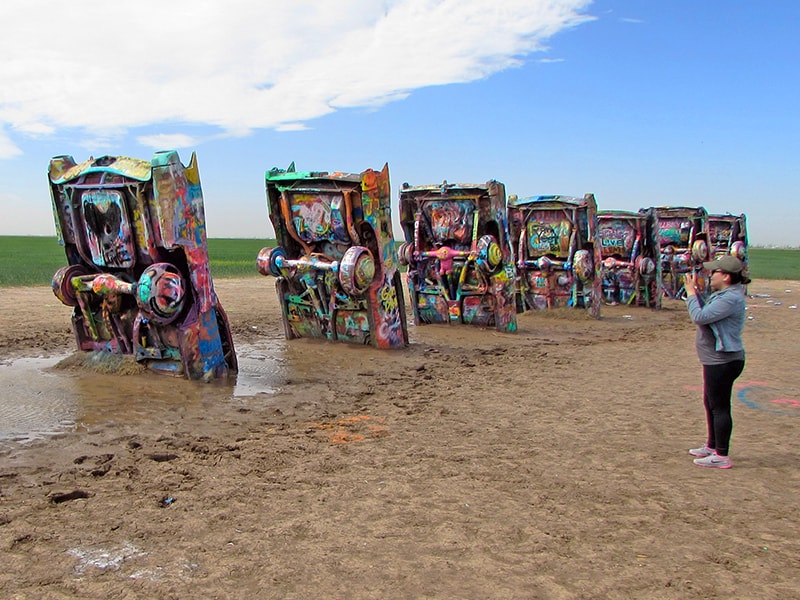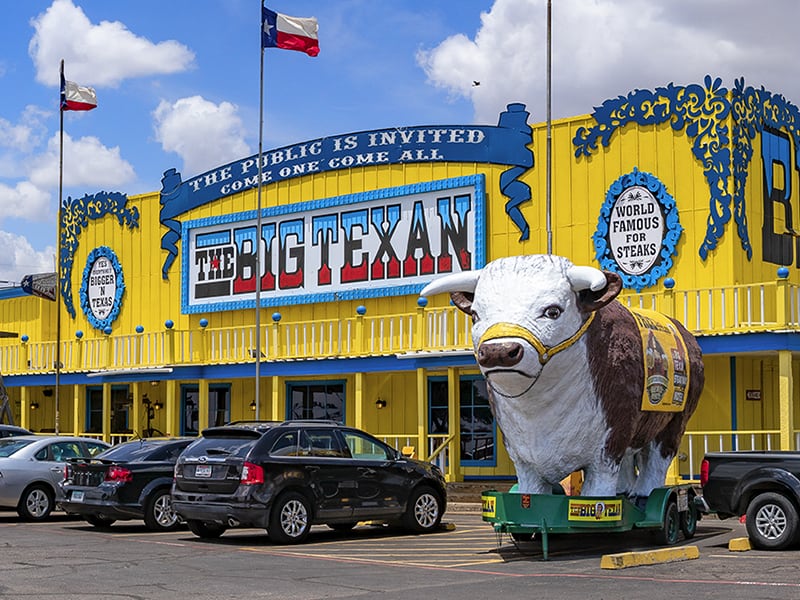Last Updated on December 13, 2023

Estimated reading time: 9 minutes
On the flat, farmland-covered Texas plain below us we can see scores of mysterious-looking crop circles. We soon learn these are the result of “central pivot irrigation.” It uses deep artesian wells and long pipes that circled the water source.
We were heading to the major Panhandle city of Amarillo, the “Yellow Rose of Texas.” Its growth in the late 19th and early 20th century is due to the railroad and cattle drives. Route 66, the famous trans-continental highway that wound its way from Chicago to Los Angeles, spurred additional growth.

Amarillo, “Capital” of the Texas Panhandle
Amarillo, with a population of just 200,000, has a remarkably large, modern airport. To get downtown we took Interstate 40, the multi-lane highway that replaced much of the Texas portion of Route 66. To its credit, the city of Amarillo has preserved a section of the old highway in the Historic District. It has also encouraged arts & crafts stores, antique shops and restaurants to locate there. In fact, one restaurant, the Golden Light Café, is the oldest restaurant on the whole Route 66.
History was also evident in our Texas Panhandle hotel, Courtyard by Marriott. Unlike most Marriott hotels, this one is on the National Register of Historic Places and was originally the 11 story Fisk Bank Building, dating from 1928. Nearby are other historical buildings like the Santa Fe Railway headquarters and the old Paramount Theatre (built in 1932 in Pueblo Deco style). Just down the wide street (extra wide for cattle drives) we had dinner at the Crush Wine Bar. We found it to be a great venue for Texas tacos, beer on tap and an excellent selection of wines.

On our first full day in Amarillo, after a great cup of java at Palace Coffee, we visited several of the city’s fascinating and quirky museums. The first is the American Quarter Horse Museum, which honors the versatile racing and work horse.
Close by was the Kwahadi Museum of the American Indian. Built as a replica Pueblo Indian kiva, the colorful museum features the crafts and culture of the Native Americans who first inhabited the area. Local children have formed a native dance troupe and give performances throughout the US.

Cadillac Ranch
After a great Tex-Mex lunch at Braceros on old Route 66, we stopped by one of the world’s unique sculptures, Cadillac Ranch. It’s a famous Texas Panhandle site and even looks a bit like Stonehenge from a distance.
Up close, however, you’ll find it’s 10 vintage Cadillacs, several with big fins from the 1949-63 era. All are half buried, nose-first, in a straight row. Graffiti is encouraged and all ten of these land yachts are covered in rainbows of color. The cars, in position sentry-like since 1974, are startling from a distance, even more so close up.
Two more Amarillo vehicle exhibits kept us busy and entertained for the afternoon. Bill’s Backyard Classics has one of the biggest displays of vintage and classic autos we’ve ever seen. It includes a 1928 Ford Paddy Wagon.
At Jack Sisemore’s RV Museum, dozens of historic Recreational Vehicles are on display. Particularly interesting are a 1948 Flxible Bus and the world’s oldest Airstream, a 1935 Torpedo owned by the Holman Family of Panama City, Florida, for 81 years.

A Texas Panhandle Legend
Amarillo has more than 500 restaurants. Its most famous, by far, is the Big Texan Steak Ranch, which is a Texas Panhandle legend. Situated close to Route 66 and alongside Interstate 40, this massive eatery has a carnival atmosphere with a big gift shop, a live rattlesnake, a shooting gallery and games of chance.
Serving more than 500,000 guests last year, its biggest novelty is the 72-ounce steak, “Free if you eat it all in one hour.” About three people a day try to consume the four and a half pound chunk of beef with sides. But, as the manager told us, only one out of six succeeds, and the other five pay $72.00. The atmosphere at the Big Texan is great fun but for normal appetites, however, quantity surpasses quality.

A Beautiful Texas Panhandle State Park
The next day, after an excellent burrito breakfast at Youngblood’s Café, we drove south to the superb Palo Duro Canyon State Park. This 120-mile gorge (two to 20 miles wide) was slowly carved by the Red River over the last million years. It’s the second biggest canyon in the United States, with only the Grand Canyon being larger. Popular with campers, the topography is rough, colorful and spectacular.
On our drive to Lubbock, two hours from Amarillo, we stopped at the Texas Panhandle-Plains Historical Museum in the town of Canyon. It’s the largest history museum in Texas and has some excellent oil drilling and windmill displays. Of course, being Texas, there’s also a large collection of historic guns.

Surprising Lubbock
Like Amarillo, Lubbock (technically in West Texas, not the Panhandle) is a delightful small city for visitors. The population of 260,000 supports the 35,000 undergraduates at Texas Tech University. The football and basketball powerhouse had just come second in the NCAA Division One basketball championship but we were even more impressed by the Spanish architecture in all the buildings (tan brick with red tile roofs) plus the remarkable outdoor public art collection throughout the campus.
https://www.roadsideamerica.com/story/17029Lubbock’s main claim to fame, however, is Buddy Holly. Born here in 1936, the rock ‘n roll legend — his family name is “Holley” — had a series of hits including “That’ll Be the Day”, “Peggy Sue”, “Oh Boy”, among others. He also influenced other great performers like Elvis, the Beatles, and Elton John before losing his life in a Iowa plane crash at the too-young age of 22.

His memory is preserved at his low-key grave site, in streets (Buddy Holly Avenue), the Buddy Holly Center (filled with memorabilia from his career) and the Buddy Holly Hall of Performing Arts and Sciences.
This acoustically ideal concert hall holds 2200 in its main auditorium and 425 in a smaller concert venue. The $155 million project was all privately funded. Organizers say it will be kept busy at least 250 nights a year. Other medium sized cities should be envious.

Buddy Holly Is Famous. Texas Wines Should Be Too
A growing grape and wine industry, particularly in West Texas with its hot days and cool nights, is making waves in sommelier circles.
We visited Lubbock Uncorked, the annual Wine ‘n Dine festival in the city’s American Windmill Museum (the largest in the world with 160 windmills inside and outside). Tasting stations featured only High Plains Texas wines, which were generally impressive, particularly the Tempranillo, Malbec and Cabernet Sauvignon.
Our favorite museum in Lubbock is Silent Wings, at the site of a former Army Air Field where glider pilots were trained for World War 2 duty between 1942 and 1945.

Little known to the public, allied aircraft towed gliders into enemy territory and then silently dropped with troops and armored vehicles. Many crashed but most were very successful in routing the Germans. The museum includes a 15-minute film and several of these engine-less airplanes that played a key role in the war.
We couldn’t leave the Texas Panhandle without barbecue so we filled up with excellent brisket at Evie Mae’s Pit BBQ in Lubbock. The lines are long but the free beer in tubs of ice make the wait worthwhile.
We also had to have a great steak and found the best one (along with signature Blood Orange Margaritas) at La Sirena in Lubbock. It’s not a Texas themed restaurant, but Latin American, a fine ending to an all-too-short visit.
As we hear several times, “Y’all come back!”
You may also enjoy: Texas Road Trip: the Chisholm Trail / Things to Do in San Antonio on a Budget / Things to Do in Oklahoma City

Hello there.My name is Bobbyand I am glad that you enjoyed Amarillo like you did.I am from Amarillo and have lived here most of my life.I just wanted to comment about your story and hope you will come back and visit again,sometime.Thank you for showcasing our cities and places.
Thank you Bobby.
Jim